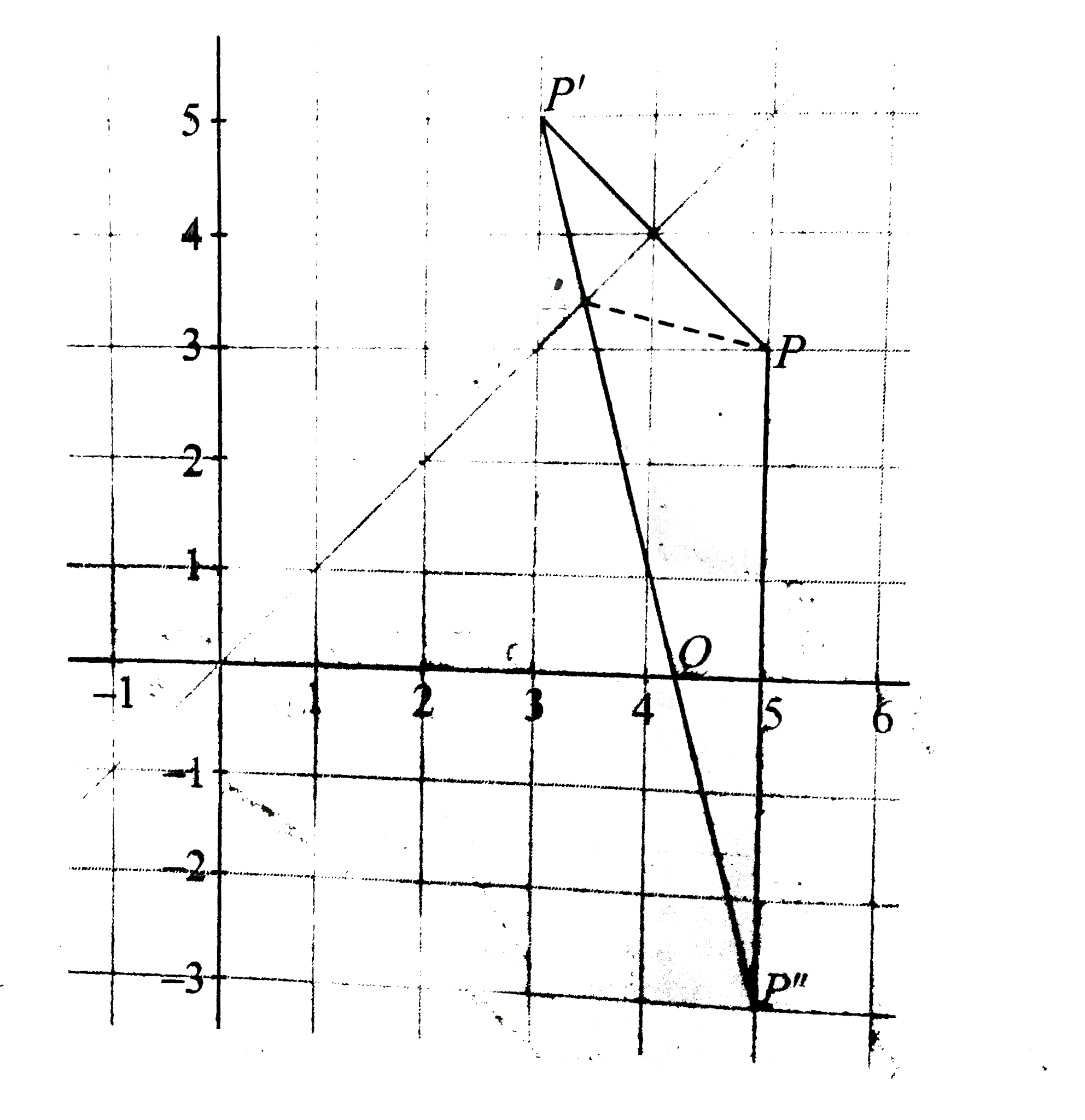Let P be (5, 3) and a point R on y=x and Q on the x-axis be such that PQ+QR+RP is minimum. Then the coordinates of Q are (174,0) (b) (17,0) (172,0) (d) none of theseSolution in Bengali
(17/4,0)
(17,0)
(17/2,0)
none of these
The correct Answer is:A

P' and P'' are the images of P w.r.t. y=x and y=0, respectively.
Therefore, P'≡(3,5).
The equation of P'P'' is
y+3=5+33−5(x−5)
∴x=5+3(−14)=174
∴Q≡(174,0)
Topper's Solved these Questions
- BOOK - CENGAGE PUBLICATIONCHAPTER - STRAIGHT LINESEXERCISE - EXERCISE (MULTIPLE CORRECT ANSWERS TYPE)30videos
STRAIGHT LINES
- BOOK - CENGAGE PUBLICATIONCHAPTER - STRAIGHT LINESEXERCISE - EXERCISE (LINKED COMPREHENSION TYPE)27videos
STRAIGHT LINES
- BOOK - CENGAGE PUBLICATIONCHAPTER - STRAIGHT LINESEXERCISE - CONCEPT APPLICATION EXERCISE 2.65videos
STRAIGHT LINES
- BOOK - CENGAGE PUBLICATIONCHAPTER - STRAIGHT LINEEXERCISE - Multiple Correct Answers Type8videos
STRAIGHT LINE
- BOOK - CENGAGE PUBLICATIONCHAPTER - THEORY OF EQUATIONSEXERCISE - JEE ADVANCED (Numerical Value Type )1videos
THEORY OF EQUATIONS
Similar Questions
If P is a point (x,y) on the line y=−3x such that P and the point (3, 4) are on the opposite sides of the line 3x−4y=8, then x>815 (b) x>85 y<−85 (d) y<−815
02:44View SolutionLet l be the line belonging to the family of straight lines (a+2b)x+(a−3b)y+a−8b=0,a,b∈R, which is farthest from the point (2,2), then area enclosed by the line L and the coordinate axes is
02:44View SolutionIf aandb are two arbitrary constants, then prove that the straight line (a−2b)x+(a+3b)y+3a+4b=0 will pass through a fixed point. Find that point.
00:37View SolutionThe point P(α,α+1) will lie inside the triangle whose vertices are A(0,3),B(−2,0) and C(6,1) if
08:06View SolutionThe number of distinct real roots of x4−4x3+12x2+x−1=0is_____.
04:33View SolutionPQRS is a trapezium having PS a n d QR as parallel sides. A is any point on PQandB is a point on SR such that ABQR . If area of PBQ is 17cm2, find the area of ASR
06:00View SolutionThe lines (p-q)x+(q-r)y+(r-p)=0(q-r)x+(r-p)y+(p-q)=0,(x-p)x+(p-q)y+(q-r)=
12:21View SolutionThe roots of the equation (q−r)x2+(r−p)x+p−q=0 are (A) r−pq−r,1 (B) p−qq−r,1 (C) q−rp−q,1 (D) r−pp−q,1
02:32View SolutionLet P be (5,3) and a point R on y = x and Q on the X - axis be such that PQ+QR+RP is minimum ,then the coordinates of Q are
04:03View SolutionLet P be (5,3) and a point R on y = x and Q on the X - axis be such that PQ+QR+RP is minimum ,then the coordinates of Q are
04:32View SolutionPQRS is a trapezium having PS and QR as parallel sides. A is any point on PQ and B is a point on SR such that AB∣∣QR . If area of △PBQ is 17 cm2, find the area of △ASR
04:32View Solutionरेखीय (p−q)x+(q−r)y+(r−p)=0
(q−r)x+(r−p)y+(p−q)=0
व (r−p)x+(p−q)y+(q−r)=0 है03:06View SolutionLet P be (5,3) and a point R on y=x and Q on the x-axis be such that PQ+QR+RP is minimum. The the coordinates of Q are
06:51View SolutionThe lines (p-q)x+(q-r)y+(r-p)=0(q-r)x+(r-p)y+(p-q)=0 (r-p)x+(p-q)y+(q-r)=0
02:47View Solutionयदि Q=p+q+r2 और (Q−p):(Q−q):(Q−r)::17:5:8, तब p:q:r=?
02:33View Solution

